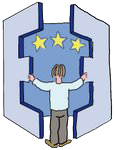History at the ESS
The S1 to S7 History programme follows a chronological timeline from prehistory to the breakup of the USSR in 1990. The students begin by exploring the question, what is history? What are historical sources? What information do they convey and how reliable are they? Students will explain the cause and effect relationship between events as well as arrange and present historical information thematically. They will be asked to analyse history through alternative perspectives and with the use of a variety of sources.
In S1- S3, students combine the study of history with that of geography, learning the basics of map reading, the position of our earth and solar system, and how climate and topography affect the lives of humans around the world. The interconnected nature of history and geography is emphasised throughout the S1-S7 cycle, however in S4, the two subjects are studied separately to allow for a more in-depth analysis.
In S3, students begin their historical/geographical studies in their second language. The opportunity to study history and geography in a second language is integral to students’ experience at the European School of Strasbourg; it is a main component of the European spirit on which the school is founded. Recognising that this is a period of transition, skills that were taught in primary and S1-S2 will be reinforced and built upon.
General periods of historical enquiry include the ancient civilisations of Mesopotamia, Egypt and China/India to the Greek and Roman world. This is followed by the Middle Ages in Europe, the age of discovery, the Renaissance and the Reformation, finishing with the Modern World. From the Enlightenment to the Industrial Revolution to the fall of the Berlin Wall, students in S6 and S7 will tackle a variety of historical issues that can be traced to their own experience in Europe today.
Students will acquire critical thinking skills as well as a technical vernacular. They will interpret, compare, and contrast historical documents and spend considerable time analysing and creating maps and graphs. Through homework assignments, quizzes and tests, individual research projects and presentations, students will demonstrate their understanding of course material.

